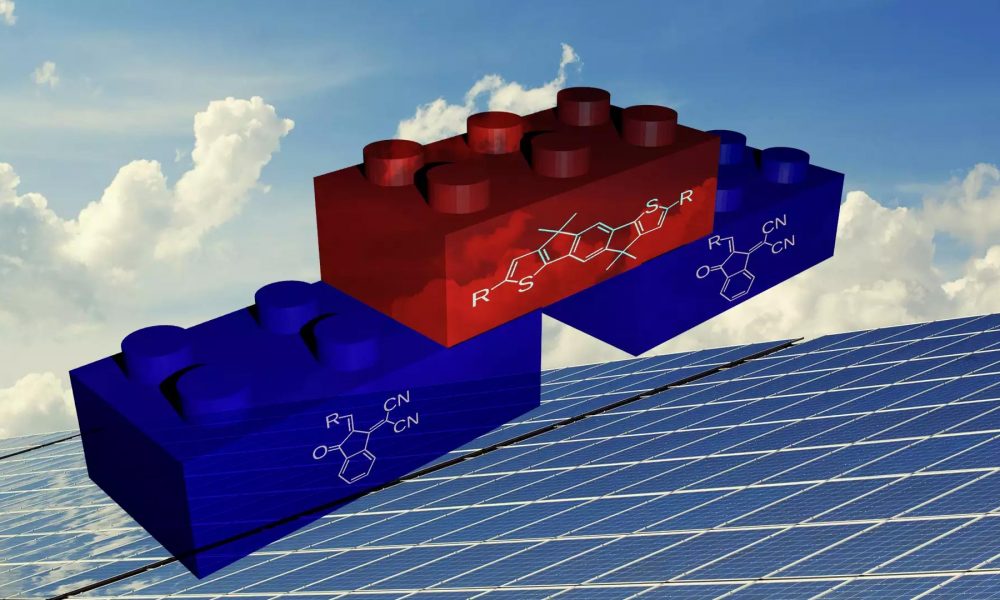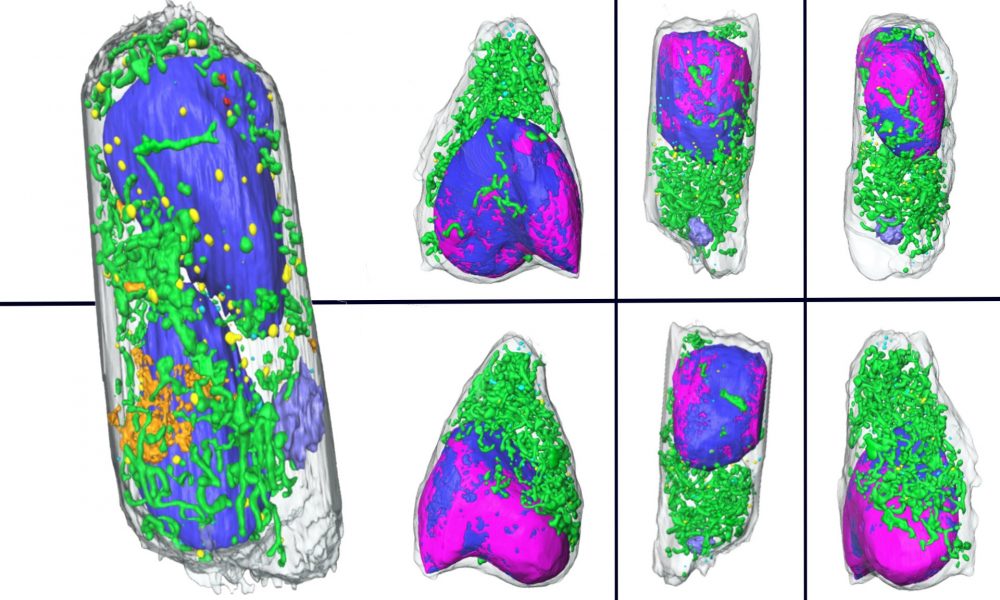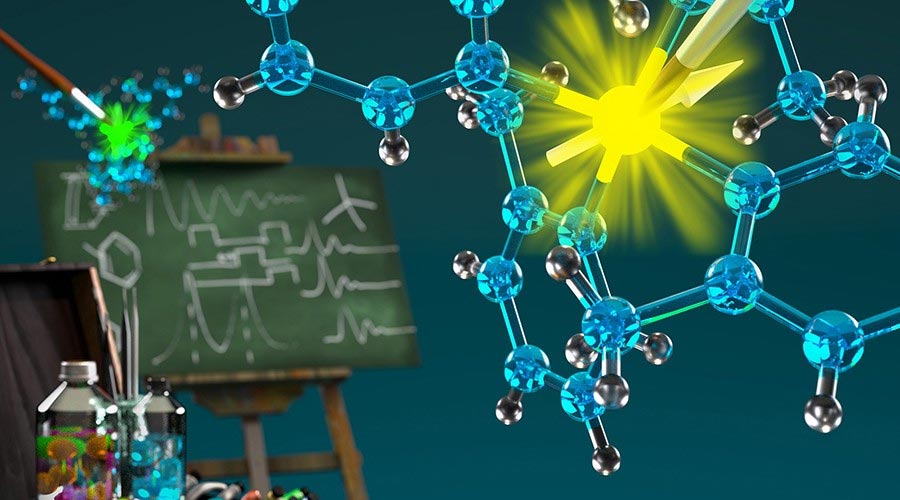An algorithm helps to find new efficient solar cell materials by reassembling known molecular building blocks of solar cells and simulating the resulting molecules. Picture credits: © MPI-P Organic, carbon-based materials are already widely used in displays, but they are also promising materials for new solar cells. However, tailoring their properties is time-consuming and requires extensive chemical synthesis and characterization. A new simulation protocol has now been developed at the Max Planck Institute for Polymer Research, which combines already known molecular building blocks into new structures and correlates them with the solar cell efficiency, thus significantly simplifying development processes. Organic solar cells could play a key role in the energy transition. However, a cheap synthesis route and high cell efficiency make a significant contribution to supporting this transition. The discovery of a new class of materials known as “non-fullerene acceptors” offers a cost-effective synthesis route compared to the more traditional silicon solar cells, while offering higher efficiency than the first organic solar cells. The design of these “non-fullerene acceptor” materials with properties tailored for use in solar cells still poses challenges. In the group of Denis Andrienko, department of Kurt Kremer at the Max Planck Institute for Polymer Research, and colleagues, a new simulation-based design methodology has now been developed to simplify this process. The design methodology leverages well-known high-efficiency organic solar cells by dividing them into multiple building blocks. These fragments consist of either electron-donating or electron-accepting molecular components called “acceptors” and “donors”. Donor and acceptor building blocks from various known solar cells can be combined to yield new “non-fullerene acceptor” molecules for use in solar cells. “It is a challenge to choose the right one from the large number of existing molecular compounds – that’s why we use our method to access existing solar cells and combine their molecular components to form new solar cells,” says Kun-Han Lin, a co-author of the study. The design algorithm contains constraints that reduce the number of possible “non-fullerene acceptor” molecules – such as molecular symmetry, quadrupole moment, ionization energy, and electron affinity. For example, in cases where an acceptor-donor-acceptor combination is used, the two acceptor building blocks are always of the same type. This design methodology is already showing promise, helping to predict solar cell efficiency before the materials are actually synthesized. “We were thrilled when we found that our method works: 10 of 12 predicted efficient solar cells have already been produced and are highly efficient,” said Andrienko. They have published their work in the renowned journal Advanced energy materials. Reference: “Chemical Design Rules for Non-Fullerene Acceptors in Organic Solar Cells” by Anastasia Markina, Kun-Han Lin, Wenlan Liu, Carl Poelking, Yuliar Firdaus, Diego Rosas Villalva, Jafar I. Khan, Sri HK Paleti, George T. Harrison, Julien Gorenflot, Weimin Zhang, Stefaan De Wolf, Iain McCulloch, Thomas D. Anthopoulos, Derya Baran, Frédéric Laquai and Denis Andrienko, October 8, 2021, Advanced energy materials.DOI: 10.1002/aenm.202102363
“Active Matter” Breakthrough Enables Shape-Shifting Next-Generation Robots
Physicists have discovered a new way to coat soft robots with materials that allow them to move and function more purposefully. Physicists have discovered a new way to coat soft robots with materials that allow them to move and function more purposefully. The research, led by the University of Bath, is detailed in a paper published in March 11, 2022 scientific advances. The study’s authors believe their groundbreaking modeling on “active matter” could mark a turning point in robot design. As the concept evolves, it may be possible to dictate the shape, motion, and behavior of a soft solid not through its natural elasticity, but through human-controlled activity on its surface. By wrapping a flexible ball (orange) in a layer of tiny robots (blue), researchers can program its shape and behavior. Credit: Jack Binysh The surface of an ordinary soft material always shrinks into a sphere. Think of the way water rolls off into droplets: Beading occurs because the surface of liquids and other soft materials naturally contract into the smallest area possible – ie a sphere. But active matter can be designed to counteract this tendency. An example of this would be a rubber ball wrapped in a layer of nanorobots, with the robots programmed to work in unison to distort the ball into a new, predetermined shape (e.g. a star). Active matter should lead to a new generation of machines whose function comes from below. Rather than being controlled by a central controller (like today’s robotic arms are controlled in factories), these new machines would consist of many individual active units that work together to determine the machine’s movement and function. This is similar to how our own biological tissues, such as B. the fibers in the heart muscle. With this idea, scientists could design soft machines with arms made of flexible materials, powered by robots embedded in their surface. They could also tailor the size and shape of drug delivery capsules by coating the surface of nanoparticles with a reactive, active material. This, in turn, could have dramatic effects on how a drug interacts with cells in the body. The work on active matter challenges the assumption that the energetic cost of the surface of a liquid or soft solid must always be positive, since a certain amount of energy is always required to create a surface. dr Jack Binysh, first author of the study, said: “Active matter allows us to look at the familiar rules of nature – rules like the fact that surface tension must be positive – in a new light. Seeing what happens when we break these rules and how we can use the results is an exciting place to do research.” Corresponding author Dr. Anton Souslov added: “This study is an important proof of concept and has many useful implications. For example, future technologies could result in soft robots that are much softer and better at picking up and manipulating delicate materials.” For the study, researchers developed a theory and simulations that described a 3D soft solid whose surface is subject to active stresses. They found that these active stresses stretch the material’s surface, dragging the underlying solid with it, and causing a global shape change. The researchers found that the precise shape the solid takes on can then be tailored by altering the elastic properties of the material. In the next phase of this work – which has already started – researchers will apply this general principle to design specific robots, such as B. soft arms or self-floating materials. You’ll also look at collective behavior – for example, what happens when you have a lot of active solids all packed together. Reference: “Active Elastocapillarity in Soft Solids with Negative Surface Tension” by Jack Binysh, Thomas R. Wilks and Anton Souslov, March 11, 2022, scientific advances.DOI: 10.1126/sciadv.abk3079 This work was a collaboration between the Universities of Bath and Birmingham. It was recognized by the Engineering and Physical Sciences Research Council (EPSRC) through New Investigator Award No. EP/T000961/1.
Scientists Discover Promising New Electrolyte for Solid-State Lithium-Ion Batteries
New battery material promises the development of all-solid batteries. In the search for the perfect battery, scientists have two main goals: to develop a device that can store a lot of energy and do it safely. Many batteries contain liquid electrolytes that are potentially flammable. As a result, solid-state lithium-ion batteries, made up of entirely solid components, are becoming increasingly attractive to scientists because they offer an enticing combination of greater safety and increased energy density — that’s how much energy the battery can store for a given volume. Researchers from[{” attribute=””>University of Waterloo, Canada, who are members of the Joint Center for Energy Storage Research (JCESR), headquartered at the U.S. Department of Energy’s (DOE) Argonne National Laboratory, have discovered a new solid electrolyte that offers several important advantages. This electrolyte, composed of lithium, scandium, indium, and chlorine, conducts lithium ions well but electrons poorly. This combination is essential to creating an all-solid-state battery that functions without significantly losing capacity for over a hundred cycles at high voltage (above 4 volts) and thousands of cycles at intermediate voltage. The chloride nature of the electrolyte is key to its stability at operating conditions above 4 volts — meaning it is suitable for typical cathode materials that form the mainstay of today’s lithium-ion cells. Chlorine-based electrolytes like the one shown here are offering improved performance for solid-state lithium-ion batteries. Credit: Image by Linda Nazar/University of Waterloo “The main attraction of a solid-state electrolyte is that it can’t catch fire, and it allows for efficient placement in the battery cell; we were pleased to demonstrate stable high-voltage operation,” said Linda Nazar, a Distinguished Research Professor of Chemistry at UWaterloo and a long-time member of JCESR. Current iterations of solid-state electrolytes focus heavily on sulfides, which oxidize and degrade above 2.5 volts. Therefore, they require the incorporation of an insulating coating around the cathode material that operates above 4 volts, which impairs the ability of electrons and lithium ions to move from the electrolyte and into the cathode. “With sulfide electrolytes, you have a kind of conundrum — you want to electronically isolate the electrolyte from the cathode so it doesn’t oxidize, but you still require electronic conductivity in the cathode material,” Nazar said. While Nazar’s group wasn’t the first to devise a chloride electrolyte, the decision to swap out half of the indium for scandium based on their previous work proved to be a winner in terms of lower electronic and higher ionic conductivity. “Chloride electrolytes have become increasingly attractive because they oxidize only at high voltages, and some are chemically compatible with the best cathodes we have,” Nazar said. “There’s been a few of them reported recently, but we designed one with distinct advantages.” One chemical key to the ionic conductivity lay in the material’s crisscrossing 3D structure called a spinel. The researchers had to balance two competing desires — to load the spinel with as many charge carrying ions as possible, but also to leave sites open for the ions to move through. “You might think of it like trying to a host a dance — you want people to come, but you don’t want it to be too crowded,” Nazar said. According to Nazar, an ideal situation would be to have half the sites in the spinel structure be lithium occupied while the other half remained open, but she explained that creating that situation is hard to design. In addition to the good ionic conductivity of the lithium, Nazar and her colleagues needed to make sure that the electrons could not move easily through the electrolyte to trigger its decomposition at high voltage. “Imagine a game of hopscotch,” she said. “Even if you’re only trying to hop from the first square to the second square, if you can create a wall that makes it difficult for the electrons, in our case, to jump over, that is another advantage of this solid electrolyte.” Nazar said that it is not yet clear why the electronic conductivity is lower than many previously reported chloride electrolytes, but it helps establish a clean interface between the cathode material and solid electrolyte, a fact that is largely responsible for the stable performance even with high amounts of active material in the cathode. A paper based on the research, “High areal capacity, long cycle life 4 V ceramic all-solid-state Li-ion batteries enabled by chloride solid electrolytes,” appeared in the January 3 online edition of Nature Energy. Reference: “High areal capacity, long cycle life 4 V ceramic all-solid-state Li-ion batteries enabled by chloride solid electrolytes” by Laidong Zhou, Tong-Tong Zuo, Chun Yuen Kwok, Se Young Kim, Abdeljalil Assoud, Qiang Zhang, Jürgen Janek and Linda F. Nazar, 3 January 2022, Nature Energy.DOI: 10.1038/s41560-021-00952-0 Other authors of the paper include Nazar’s graduate student, Laidong Zhou, a JCESR member who was responsible for the majority of the work, and Se Young Kim, Chun Yuen Kwok and Abdeljalil Assoud, all of UWaterloo. Additional authors included Tong-Tong Zuo and Professor Juergen Janek of Justus Liebig University, Germany and Qiang Zhang of the DOE’s Oak Ridge National Laboratory. The research was funded by the DOE’s Office of Science, Office of Basic Energy Sciences with some support from Canada’s National Sciences and Engineering Research Council.
Safely Studying Dangerous Infections – Like COVID – Just Got a Lot Easier
Digital images of SARS-CoV-2 infected cells created from soft X-ray tomography acquired from chemically fixed cells at the Advanced Light Source. Image credit: Loconte et al./Berkeley Lab An extremely fast new 3D imaging technique can show how cells respond to infection and possible treatments. To fight a pandemic, science must act quickly. With safe and effective vaccines now in widespread use and a handful of promising ones[{” attribute=””>COVID-19 treatments coming soon, there’s no doubt that many aspects of biological research have been successfully accelerated in the past two years. Now, researchers from Lawrence Berkeley National Laboratory (Berkeley Lab) and Heidelberg University in Germany have cranked up the speed of imaging infected cells using soft X-ray tomography, a microscopic imaging technique that can generate incredibly detailed, three-dimensional scans. Their approach takes mere minutes to gather data that would require weeks of prep and analysis with other methods, giving scientists an easy way to quickly examine how our cells’ internal machinery responds to SARS-CoV-2, or other pathogens, as well as how the cells respond to drugs designed to treat the infection. “Prior to our imaging technique, if one wanted to know what was going on inside a cell, and to learn what changes had occurred upon an infection, they’d have to go through the process of fixing, slicing, and staining the cells in order to analyze them by electron microscopy. With all the steps involved, it would take weeks to get the answer. We can do it in a day,” said project co-lead Carolyn Larabell, a Berkeley Lab faculty scientist in the Biosciences Area. “So, it really speeds up the process of examining cells, the consequences to infection, and the consequences of treating a patient with a drug that may or may not cure or prevent the disease.” Taking cellular freeze frames Larabell is a professor of anatomy at UC San Francisco and director of the National Center for X-Ray Tomography, a facility based at Berkeley Lab’s Advanced Light Source (ALS). The facility’s staff developed soft X-ray tomography (SXT) in the early 2000s to fill in the gaps left by other cellular imaging techniques. They currently offer the SXT to investigators worldwide and continue to refine the approach. As part of a study published in Cell Reports Methods late last year, she and three colleagues performed SXT on human lung cell samples prepared by their colleagues at Heidelberg University and the German Center for Infection Research. Led by virologist Ralf Bartenschlager and physicist Venera Weinhardt, the German team carefully infected the cells with SARS-CoV-2 then chemically fixed them with aldehyde-based compounds – a process that kills cells and preserves them, immobilized, in their last living state (and also inactivates any remaining viral particles) – at 6 and 24 hours post-infection. Valentina Loconte and Jian-Hua Chen, mounting a new cell sample on the X-ray microscope at the National Center for X-Ray Tomography. Credit: Berkeley Lab The entire team was jubilant when the resulting 3D images had the same level of exquisite detail and clarity that SXT is known for, despite the chemical fixation done to the cells. The takeaway is that their approach will allow many labs to safely image infected cells without the inherent risks – and corresponding required safety protocols – of working with live infected cells. “This is a really important point because there’s a lot of dangerous organisms that people can’t study because not everybody has a BSL-3 (Biosafety Level 3) lab,” Larabell explained. “Nobody at Berkeley Lab, for example, is able to have those cells growing in their lab. So, it opens up the doors to a lot of experiments on pathogens that we couldn’t image before.” Jian-Hua Chen and Valentina Loconte, scientists in Larabell’s group, conducted the tomography sessions and image analysis, respectively, at the National Center for X-Ray Tomography. Both were pleasantly surprised to see how SXT captured changes to different organelles within the lung cells at very high resolution after very little time spent on sample preparation and without use of stains or labeling. These additional steps are often needed to generate cell maps wherein the different internal components are easily distinguishable. “One detail that hit me was the presence of this large membrane compartment that is probably the way the cell tries to recycle or remove all of the viral reproductive machineries,” said Loconte, a postdoctoral researcher. She noted that the images showed the development of this peculiar compartment in nearly all the infected cells they studied. “It was highlighted really clearly by our technique. If we were using transmission electron microscopy (TEM), for instance, it would have taken so much longer to track a single organelle like this,” because scientists using TEM have to slice the cells, analyze each particular slice independently, and then reconstruct the area, she said. Spreading the news Now that they’ve demonstrated the potential of using whole-cell SXT to safely image virus-infected cells, the authors believe that their findings will help the global scientific community study COVID-19 and potentially other diseases. Meanwhile, Larabell, Weinhardt, and Bartenschlager are already putting the technique to good use. As part of his role at the German Center for Infection Research, Bartenschlager and his team have begun using whole-cell SXT to examine how human cells respond to several experimental COVID-19-treating drugs. They hope the rapid turnaround for results will help expedite the drug development process, getting additional effective treatments on the market sooner. They also plan to use the technology to understand the progress of infections caused by other viral agents. “Being microscopists, we often say ‘seeing is believing.’ However, there are still a lot of unknowns for us to explore to get a better understanding of the complexities of virus-host interactions. This will require imaging large numbers of cells to obtain statistically significant information, given the variations between infected cells that we observed,” said Chen. “SXT offers the community a very good chance to observe and investigate what happens after human cells have been infected by viruses. I’m hoping this will open
You can now install Windows on your Steam Deck
Valve has announced the release of Windows drivers for its Steam Deck portable game console. This is big news because it now allows Steam Deck owners to install Windows on their consoles and use the device as a portable PC. However, the drivers that the company releases are intended for Windows 10 and not the latest Windows 11 operating system. Also read – Studio Display works with Windows PCs, but Apple as Apple limits its capabilities The company has already released Windows 10 drivers for the GPU, Wi-Fi and Bluetooth. It has announced that it is currently working with AMD on audio drivers. This means that you can currently install Windows 10 on your Steam Deck but will not get any audio output through the speakers or the 3.5mm headphone jack. However, users can still connect external speakers, headphones via Bluetooth and/or via USB. Also Read – Microsoft Finally Releases a New Video Editor for Windows, But It Costs More Than Adobe Premiere Pro Valve has also announced that it is also working with AMD on Windows 11 drivers, which will later be rolled out with a BIOS update that will enable fTPM support, which is mandatory for Windows 11. It’s also working on adding support for dual booting, which will be introduced later this year. Currently, if users want to install Windows on their Steam deck, they have to replace the existing SteamOS and vice versa if they want to go back. Also read – MWC 2022: Realme Book Prime launched with 11th Gen Intel processor and 16GB RAM Since Steam Deck is an x86-based PC, on paper you can install any desktop operating system. However, full functionality still requires native driver support. The device comes preinstalled with Valve’s SteamOS, which supports the Proton emulator to run Windows games available on the Steam Store. SteamOS does not currently support all games on the Steam Store, nor does it support installing games from other sources. For that reason, the ability to switch to Windows is a welcome change.
A Powerful New Platform for Customizable Quantum Devices
Researchers are bringing together the tools of chemistry and physics to develop rules for designing tunable molecular qubits. Credit: Image by University of Chicago. A fundamental approach to qubit design leads to a new framework for creating versatile, highly customized quantum devices. Advances in quantum science have the potential to revolutionize the way we live. Quantum computing holds promise for solving problems that are unsolvable today, and we may one day use quantum networks as hack-proof information superhighways. The realization of such pioneering technologies depends to a large extent on the qubit – the fundamental component of quantum systems. A major challenge of qubit research is designing them to be customizable and tailored to work with all types of sensing, communication, and computing devices. Scientists have taken a major step in developing custom qubits. In one in the Journal of the American Chemical Societythe team, which also includes researchers[{” attribute=””>MIT, the University of Chicago, and Columbia University, demonstrates how a particular molecular family of qubits can be finely tuned over a broad spectrum, like turning a sensitive dial on a wideband radio. The team also outlines the underlying design features that enable exquisite control over these quantum bits. “This is a new platform for qubit design. We can use our predictable, controllable, tunable design strategy to create a new quantum system,” said Danna Freedman, MIT professor of chemistry and a co-author of the study. “We’ve demonstrated the broad range of tunability over which these design principles work.” The work is partially supported by Q-NEXT, a U.S. Department of Energy (DOE) National Quantum Information Science Research Center led by Argonne National Laboratory. The researchers’ work focuses on a specific group of molecules: those with a central chromium atom surrounded by four hydrocarbon molecules to form a pyramidlike structure. The molecular qubit advantage The qubit is the quantum equivalent of the traditional computing bit. Physically, it may take any of several forms, such as a specially prepared atom inside a crystal or an electrical circuit. It can also be a lab-made molecule. One advantage of a molecular qubit is that, like a tiny 3D-printed gadget, it can be engineered from the bottom up, giving the scientist freedom to tune the qubit for different functions. “We’re working to change the atomic structure through synthetic chemistry and then learning how those changes modify the physics of the qubit,” said Leah Weiss, a University of Chicago postdoctoral researcher and study co-author. A molecular qubit’s information is stored in its spin, a property of atomic-level materials. Scientists engineer the spin by adjusting — tuning — the arrangement of the molecule’s electrons, its electronic structure. The information enters the qubit as particles of light, or photons, and is encoded in the qubit’s spin. The spin-encoded information is then translated again into photons, to be read out. Different photon wavelengths are more suitable for different applications. One wavelength may work better for biosensing applications, another for quantum communication. The ligand’s the thing One of the molecular qubit’s key tuning dials is the ligand field strength, the strength of the bonds connecting the central metal atom to the surrounding hydrocarbons. “The ligand is fundamentally everything. We can intentionally control the way in which the ligand environment influences the spin and rationally control where the emitted photons end up,” said Dan Laorenza, MIT graduate student and lead author of the paper. Researchers demonstrated that they could exercise remarkably fine tuning over these bonds. Not only that, but they also showed that the ligand field strengths are adjustable over a relatively broad spectrum, while computational simulations performed by researchers at Columbia provided quantum mechanical insight into the ligands’ role in controlling the molecule’s electronic properties. The light emitted by their chromium qubits spanned an impressive 100 nanometers. “This is an unprecedented range of tunability for qubits targeting designer applications,” Freedman said. “Just by keeping the central metal ion the same, which is doing the hard work of the quantum information processing, but tuning the surrounding environment through ligands, you can play around with the properties,” said University of Glasgow’s Sam Bayliss, who co-authored the study while a postdoctoral researcher at the University of Chicago. “That’s very hard to do with other systems, like solid-state systems, where you’re essentially fixed at whatever the elemental properties give you.” A solid-state qubit is created by scooping out a tiny, atom-sized bit of matter from a crystal, and the resulting vacancy is where quantum information is stored and processed. While they have their advantages, solid-state qubits can’t be tuned with the same chemical precision, for example. “With those, effectively, you get no tuning,” Freedman said. “You’re really going from zero to 100 there.” Laying out the design rules Approaching the molecule’s design by focusing on its electronic structure — the molecule’s energy levels — rather than its physical structure was key to the team’s discovery. “Throwing the physical structure out the window and focusing entirely on the electronic structure, which is something that can be achieved across a range of molecular platforms, is really the key innovative detail,” Freedman said. The researchers spell out the design criteria for building similar molecules in their paper, laying the groundwork for creating new tunable molecular qubits that can be designed toward a future application. “Having demonstrated the accuracy of our computational methods on these chromium qubits, we can now use the same methods to simplify the screening process,” said Arailym Kairalapova, one of the Columbia researchers who performed the calculations. “By bringing together the tools of chemistry and physics, it’s possible to start to understand the design rules that will guide the continued improvement of this class of qubits,” Weiss said. One could custom-design qubits that attach to a biological system and use them for quantum biosensing. Or researchers could architect a qubit to be water-soluble so that it could detect signals in an aqueous environment. “One of the terrific things about this platform is that, if the molecule doesn’t emit at a certain wavelength, it’s easy
Best 5 upcoming mobile games to look forward in 2022
Call of Duty Warzone Activision confirmed in its latest announcement that Call of Duty: Warzone is set to load on mobile devices. According to the developer, the large-scale BR experience is said to have been developed natively for mobile devices using cutting-edge technology. Activision had acquired Respawnables developer Digital Legends to develop the new Call of Duty version. However, several other studios are said to be on the list as well. Call of Duty Mobile is already putting on a fierce battle for BGMI and PUBG Mobile, the new version will probably compete against PUBG New State.
Machine-Learning Models That Produce Fair Outputs Even When Trained on Unfair Data
A new technique improves models’ ability to reduce bias even when the data set used to train the model is imbalanced. If a machine learning model is trained on an unbalanced dataset, which contains far more images of light-skinned people than darker-skinned people, for example, there is a serious risk that the model’s predictions will be unfair when deployed in the real world . But that’s only part of the problem.[{” attribute=””>MIT researchers have found that machine-learning models that are popular for image recognition tasks actually encode bias when trained on unbalanced data. This bias within the model is impossible to fix later on, even with state-of-the-art fairness-boosting techniques, and even when retraining the model with a balanced dataset. So, the researchers came up with a technique to introduce fairness directly into the model’s internal representation itself. This enables the model to produce fair outputs even if it is trained on unfair data, which is especially important because there are very few well-balanced datasets for machine learning. The solution they developed not only leads to models that make more balanced predictions, but also improves their performance on downstream tasks like facial recognition and animal species classification. MIT researchers have found that, if a certain type of machine learning model is trained using an unbalanced dataset, the bias that it learns is impossible to fix after the fact. They developed a technique that induces fairness directly into the model, no matter how unbalanced the training dataset was, which can boost the model’s performance on downstream tasks. Credit: Jose-Luis Olivares, MIT “In machine learning, it is common to blame the data for bias in models. But we don’t always have balanced data. So, we need to come up with methods that actually fix the problem with imbalanced data,” says lead author Natalie Dullerud, a graduate student in the Healthy ML Group of the Computer Science and Artificial Intelligence Laboratory (CSAIL) at MIT. Dullerud’s co-authors include Kimia Hamidieh, a graduate student in the Healthy ML Group; Karsten Roth, a former visiting researcher who is now a graduate student at the University of Tubingen; Nicolas Papernot, an assistant professor in the University of Toronto’s Department of Electrical Engineering and Computer Science; and senior author Marzyeh Ghassemi, an assistant professor and head of the Healthy ML Group. The research will be presented at the International Conference on Learning Representations. Defining fairness The machine-learning technique the researchers studied is known as deep metric learning, which is a broad form of representation learning. In deep metric learning, a neural network learns the similarity between objects by mapping similar photos close together and dissimilar photos far apart. During training, this neural network maps images in an “embedding space” where a similarity metric between photos corresponds to the distance between them. For example, if a deep metric learning model is being used to classify bird species, it will map photos of golden finches together in one part of the embedding space and cardinals together in another part of the embedding space. Once trained, the model can effectively measure the similarity of new images it hasn’t seen before. It would learn to cluster images of an unseen bird species close together, but farther from cardinals or golden finches within the embedding space. This image shows two distinct PARADE embeddings for bird color. On the left, both example images are mapped to clusters with birds of the same plumage. On the right in the class label embedding, due to de-correlation, the images are separated from the region of space with other birds of the same plumage, but are still well-clustered, indicating that PARADE can find other attributes to distinguish these species clusters. Credit: Courtesy of the researchers The similarity metrics the model learns are very robust, which is why deep metric learning is so often employed for facial recognition, Dullerud says. But she and her colleagues wondered how to determine if a similarity metric is biased. “We know that data reflect the biases of processes in society. This means we have to shift our focus to designing methods that are better suited to reality,” says Ghassemi. The researchers defined two ways that a similarity metric can be unfair. Using the example of facial recognition, the metric will be unfair if it is more likely to embed individuals with darker-skinned faces closer to each other, even if they are not the same person, than it would if those images were people with lighter-skinned faces. Second, it will be unfair if the features it learns for measuring similarity are better for the majority group than for the minority group. The researchers ran a number of experiments on models with unfair similarity metrics and were unable to overcome the bias the model had learned in its embedding space. “This is quite scary because it is a very common practice for companies to release these embedding models and then people finetune them for some downstream classification task. But no matter what you do downstream, you simply can’t fix the fairness problems that were induced in the embedding space,” Dullerud says. Even if a user retrains the model on a balanced dataset for the downstream task, which is the best-case scenario for fixing the fairness problem, there are still performance gaps of at least 20 percent, she says. The only way to solve this problem is to ensure the embedding space is fair to begin with. Learning separate metrics The researchers’ solution, called Partial Attribute Decorrelation (PARADE), involves training the model to learn a separate similarity metric for a sensitive attribute, like skin tone, and then decorrelating the skin tone similarity metric from the targeted similarity metric. If the model is learning the similarity metrics of different human faces, it will learn to map similar faces close together and dissimilar faces far apart using features other than skin tone. Any number of sensitive attributes can be decorrelated from the targeted similarity metric in this way. And because the similarity metric for the sensitive attribute is
Apple iPhone, iPad users on Arcade to soon get new social racing game
During the Apple Event, Apple showed a game called Gear.Club Stradale. This new title is developed by Eden Games. The new racing game will soon be included in Apple Arcade games. Also read – Apple could finally be working on a gaming console after 24 years of discontinuing its original console Gear.Club Stradale game The social racing game on Apple Arcade allows players and five of their friends to drive supercars from real automakers including Bugatti, Porsche and McLaren. Also read – Apple claims to have over 745 million paid subscriptions for its online services Players move into their own villa in the most beautiful region of Italy: Tuscany, where they create or join a club to compete in club races and events, make visual and performance upgrades to their cars, and expand their villa to make a name for themselves to do for yourself in the region. Also Read – Disney Melee Mania Coming to Apple Arcade Exclusively in December As the player’s reputation grows, he uses resources to buy new cars. Players can also party with other friends in a shared showroom. Players can use their best cars to collect rewards in the Carta Stradale racing mode, where they work together with their friends to take their club to the top against other clubs. The game is developed by Eden Games based in France. The studio specializes in the design and production of racing games. Other popular titles released from the studio include the V-Rally and Test Drive Unlimited franchises. What is Apple Arcade? Apple Arcade is a game subscription service that offers unlimited access to a growing collection of over 200 premium games – featuring new releases, award winners and popular favorites from the App Store, all with no ads or in-app purchases. You can play Apple Arcade games on iPhone, iPad, iPod touch, Mac and Apple TV. Apple Arcade Prize Apple Arcade is free to try for 1 month and then costs ₹99 per month. The company offers a family sharing feature that allows users to share their subscription with up to five family members.The user can also get 3 months of Apple Arcade for free when purchasing an Apple device. Apple One lets you bundle Apple Arcade with Apple Music, Apple TV+, and iCloud storage for one low monthly price.
How To Help Humans Understand Robots – To Collaborate Faster and More Effectively
MIT and Harvard researchers suggest that applying theories from cognitive science and educational psychology to the field of human-robot interaction can help people create more accurate mental models of their robotic collaborators, which can improve performance and safety in collaborative environments work areas could improve. Photo credit: MIT News, iStockphoto Theories from cognitive science and psychology could help people learn to collaborate with robots faster and more effectively, scientists find. Scientists studying human-robot interaction often focus on understanding human intentions from a robot’s perspective so that the robot learns to work more effectively with humans. But human-robot interaction is not a one-way street, and humans also need to learn how the robot behaves. Thanks to decades of cognitive science and educational psychology research, scientists have a pretty good grasp of how people learn new concepts. So, researchers at[{” attribute=””>MIT and Harvard University collaborated to apply well-established theories of human concept learning to challenges in human-robot interaction. They examined past studies that focused on humans trying to teach robots new behaviors. The researchers identified opportunities where these studies could have incorporated elements from two complementary cognitive science theories into their methodologies. They used examples from these works to show how the theories can help humans form conceptual models of robots more quickly, accurately, and flexibly, which could improve their understanding of a robot’s behavior. Humans who build more accurate mental models of a robot are often better collaborators, which is especially important when humans and robots work together in high-stakes situations like manufacturing and health care, says Serena Booth, a graduate student in the Interactive Robotics Group of the Computer Science and Artificial Intelligence Laboratory (CSAIL), and lead author of the paper. “Whether or not we try to help people build conceptual models of robots, they will build them anyway. And those conceptual models could be wrong. This can put people in serious danger. It is important that we use everything we can to give that person the best mental model they can build,” says Booth. Booth and her advisor, Julie Shah, an MIT professor of aeronautics and astronautics and the director of the Interactive Robotics Group, co-authored this paper in collaboration with researchers from Harvard. Elena Glassman ’08, MNG ’11, PhD ’16, an assistant professor of computer science at Harvard’s John A. Paulson School of Engineering and Applied Sciences, with expertise in theories of learning and human-computer interaction, was the primary advisor on the project. Harvard co-authors also include graduate student Sanjana Sharma and research assistant Sarah Chung. The research will be presented at the IEEE Conference on Human-Robot Interaction. A theoretical approach The researchers analyzed 35 research papers on human-robot teaching using two key theories. The “analogical transfer theory” suggests that humans learn by analogy. When a human interacts with a new domain or concept, they implicitly look for something familiar they can use to understand the new entity. The “variation theory of learning” argues that strategic variation can reveal concepts that might be difficult for a person to discern otherwise. It suggests that humans go through a four-step process when they interact with a new concept: repetition, contrast, generalization, and variation. While many research papers incorporated partial elements of one theory, this was most likely due to happenstance, Booth says. Had the researchers consulted these theories at the outset of their work, they may have been able to design more effective experiments. For instance, when teaching humans to interact with a robot, researchers often show people many examples of the robot performing the same task. But for people to build an accurate mental model of that robot, variation theory suggests that they need to see an array of examples of the robot performing the task in different environments, and they also need to see it make mistakes. “It is very rare in the human-robot interaction literature because it is counterintuitive, but people also need to see negative examples to understand what the robot is not,” Booth says. These cognitive science theories could also improve physical robot design. If a robotic arm resembles a human arm but moves in ways that are different from human motion, people will struggle to build accurate mental models of the robot, Booth explains. As suggested by analogical transfer theory, because people map what they know — a human arm — to the robotic arm, if the movement doesn’t match, people can be confused and have difficulty learning to interact with the robot. Enhancing explanations Booth and her collaborators also studied how theories of human-concept learning could improve the explanations that seek to help people build trust in unfamiliar, new robots. “In explainability, we have a really big problem of confirmation bias. There are not usually standards around what an explanation is and how a person should use it. As researchers, we often design an explanation method, it looks good to us, and we ship it,” she says. Instead, they suggest that researchers use theories from human concept learning to think about how people will use explanations, which are often generated by robots to clearly communicate the policies they use to make decisions. By providing a curriculum that helps the user understand what an explanation method means and when to use it, but also where it does not apply, they will develop a stronger understanding of a robot’s behavior, Booth says. Based on their analysis, they make a number recommendations about how research on human-robot teaching can be improved. For one, they suggest that researchers incorporate analogical transfer theory by guiding people to make appropriate comparisons when they learn to work with a new robot. Providing guidance can ensure that people use fitting analogies so they aren’t surprised or confused by the robot’s actions, Booth says. They also suggest that including positive and negative examples of robot behavior, and exposing users to how strategic variations of parameters in a robot’s “policy” affect its behavior, eventually across strategically varied environments, can help humans learn better and faster. The robot’s policy is a mathematical function













